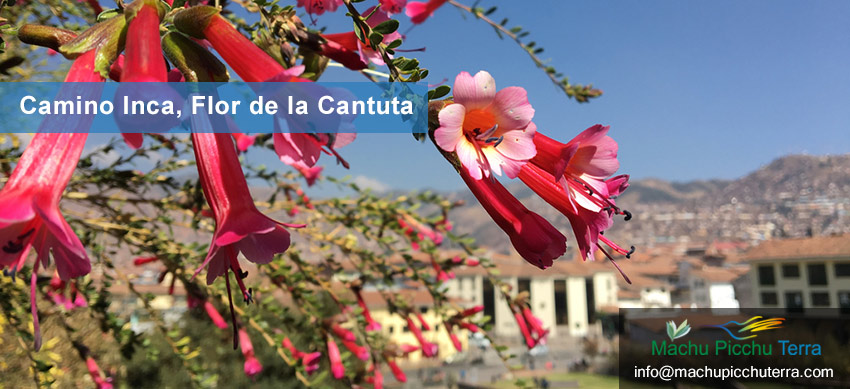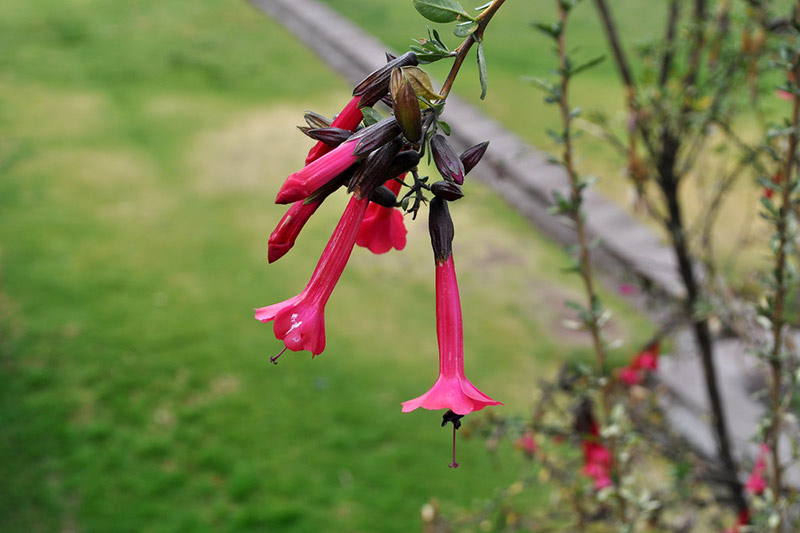
The cantuta flower is one of the most emblematic flowers of Peru. It is that it has the particularity of growing at different altitudes, it can even be seen growing and decorating some places in Puno, Huancavelica, Arequipa, and Cusco. In addition, for many historians, anthropologists, and other specialists, the cantuta flower was of great importance for the Inca ceremonies. During the route along the Inca Trail or visiting some places in Cusco, you can appreciate this native flower of the lands of the Inca. For this reason, we now want to show a little more information and where we can find this flower that seems to be the favorite of hummingbirds.
What is the cantuta flower?
This flower, which is usually red in color and the petals give it a tubular shape, grows in many regions of Peru. It is currently considered, with merit, as the National Flower of Peru, for which several biologists and anthropologists are fighting so that it can officially receive that title. This flower receives the scientific name of ” Cantua buxifolia ”. One of its main characteristics is that it has an intense color and grows on branched stems that give it the shape of a shrub that can grow more than 2 meters. Although the most characteristic color is red, you can find different variations that also have a strong intensity in their colors such as yellow, White, and pink. The places where it is most common to find them are throughout the region of Cusco, Huancavelica, Huánuco, the Mantaro Valley, Ancash, Arequipa, Moquegua, and other regions.
Currently, the cantuta flower receives a lot of admiration as an ornamental flower, but not only for its flowers. This flower is also for the ability it has to form arches and live fences that help decorate gardens and even delimit them. This flower, thanks to its strong and intense colors, attracts the presence of bees and hummingbirds, which help them pollinate, in this way it can develop naturally in other spaces. At present, through hybridization methods, a greater quantity and variety of colors can be obtained. The cantuta flower can grow in frigid climates as long as they have some shelter. In warmer climates, they will not need such care. This flower is one of those that bloom during the winter (that is, between the months of June and September), which magnifies its legend as it is considered a sacred flower for the Incas. Also, this makes it ideal for relatively cold climates.
Influence of the flower throughout its history

Cantuta’s flower
As we currently mentioned, the cantuta flower should be considered, legally, as the National flower of Peru. In this section, we will explain why it should have that title. It all starts in ancient Peru, when the Incas were still sovereign, even much earlier in the oldest cultures. All these already appreciated the beauty of this particular flower. According to some chronicles of the Spanish conquest and the next narrations that were given, they mention and agree that the petals of this flower were used to decorate the roads where the Inca would pass during the different ceremonies. It is for this reason that it was known as the Sacred Flower of the Inca. It was also used to demarcate sacred spaces.
Currently, these traditions persist in some Cusco communities. For example, in the communities of Sacaca and Chahuaytiri as a way of showing the corresponding respect to the ancient deities known as the apus. The inhabitants of these communities leave small offerings on the slopes and in places considered sacred in the mountains. These offerings are decorated with bouquets of this flower. Also some religious decorations of the Catholic Church, such as crosses and decorate the floor in the form of a carpet during the processions of saints and virgins. One of the most symbolic uses is that women can use it as a necklace, thus making it known that they are single. This is during some festivities. The same corsage is also used to hang on the doors as a symbol of hospitality and welcome.
The Cantuta Flower receives several names. It is probable that during your journey on the conozcan as flor de la cantuta, bell as: La flor Sagrada de los Incas, cantu, cantuta, ccantu, flor del inca, jinilla, ccanta, ccelmo. Great, despite the great variety of names, this plant in all places is recognized as a sacred plant, beautiful and of vital importance to Peru for its historical legacy and great power to resonate in the identity of Peruvians.
Cantuta flower benefits
The benefits of this flower or plant are multiple, let’s find out below some of the most common uses that people attributed to it.
- We have already seen that the cantuta flower was considered a sacred flower in the past and that it had different symbolic uses linked to Andean religiosity. However, thanks to its natural properties, it can be used beyond the ornamental.
- According to some studies carried out, the branches and flowers of this flower have assets that help regulate indigestion caused by diarrhea, that is, it is an antidiarrheal.
- These same branches can also be very useful for making high-quality baskets. The fiber of its branches is quite resistant and thin slats can be created, ideal for baskets or similar products.
- Although it may seem unbelievable, the composition of the thickest trunks and branches helps in the making of musical instruments. Especially in the Acora district, where lahuaccumu is made, which is very similar to pinkullos. They are very similar to quenas or flutes, but thinner.
- It can serve as a dye for the wool of some camelid. For this, you can use the stem and leaves. The result is a yellow tint.
The cantuta flower on the Inca Trail
The cantuta flower can be found on the Inca Trail, either during the 4-day trek that is known as the classic. You can also find some bushes of this plant if you do the Short Inca Trail of only 2 days until you reach Machu Picchu. The possibilities of seeing this plant during the walk are immense, in addition, it is quite likely that you will find it in some country area of Cusco or in some of the gardens of the hotel where you are staying or similar. If you can’t find it, you’ll have to go to Plaza San Blas, where you can find a copy.
Returning to the Inca Trail trek, you will have to be attentive to the bushes or flowers if you want to meet this sacred flower. You are more likely to find it when you start the walk. It will also be possible to find it at some control points or the booths of the Ministry of Culture workers, who will be in charge of allowing you access and safeguarding the entire path. Keep in mind that you can arrive in Cusco at the time when it does not bloom, remember that this flower, unlike the rest, blooms in the southern winter, that is, during the months of June to September.
In what other places can we find the cantuta flower?
The cantuta flower can grow in different geographical spaces. The altitudinal limits in which we can find this incredible plant are from 1,200 to 3,800 meters above sea level. For this reason, it can grow without problems throughout the entire Peruvian highlands. It also has a strong presence in the highlands, that is, in the Puno region. They have quite a presence in the regions of Huancavelica, Huánuco, Cajamarca Puno, and more. This amazing plant could grow anywhere. For this, it will only be necessary clayey soil and loose soils that allow free transit or the water can drain without problems.
By Inca Trail Machu Picchu - Last updated, 22-08-2024
Interested in the Inca Trail? Know more about Nature!
- Coca leaf, ideal for trekking in Peru
- Fauna of the Inca Trail
- Spectacled bear on the Inca Trail to Machu Picchu
- The cock of the rocks on the Inca Trail
- Inca Trail: butterfly observatory
- Warmiwañusca Mountain Pass
